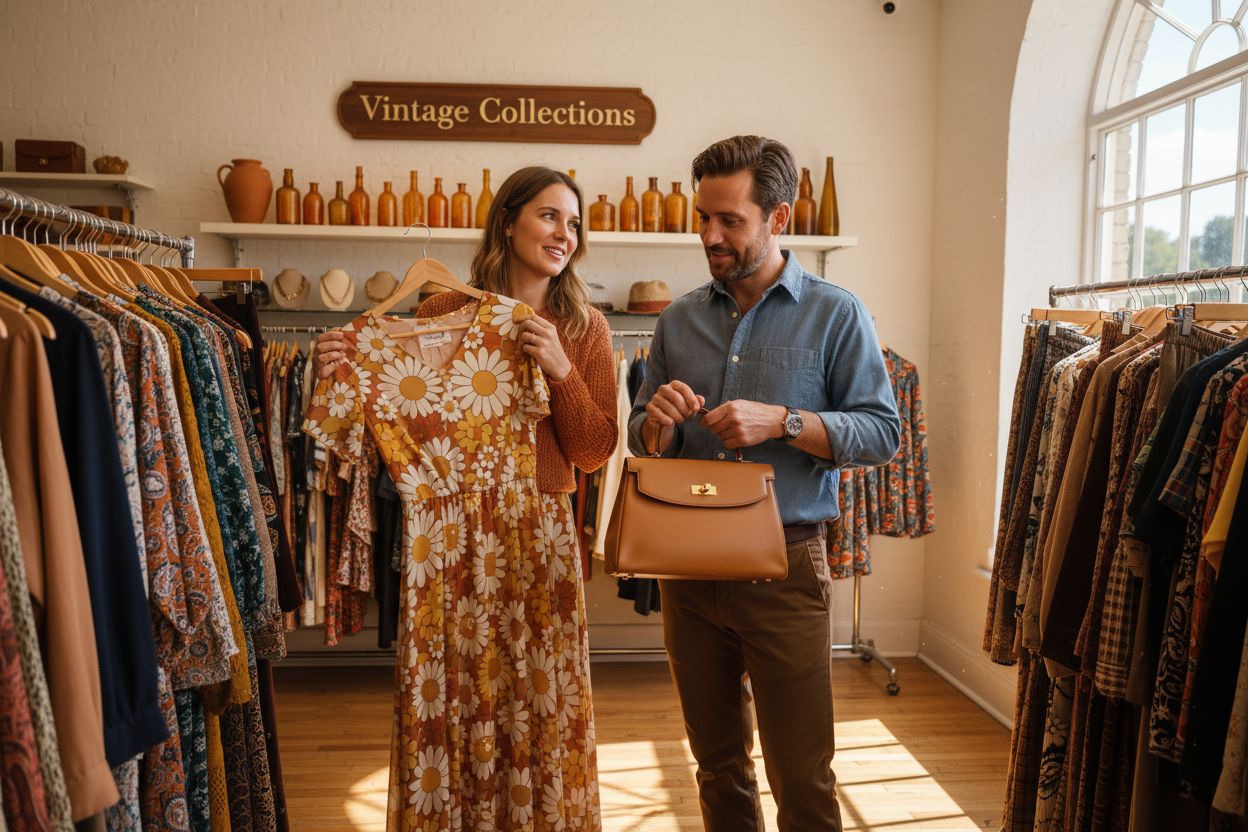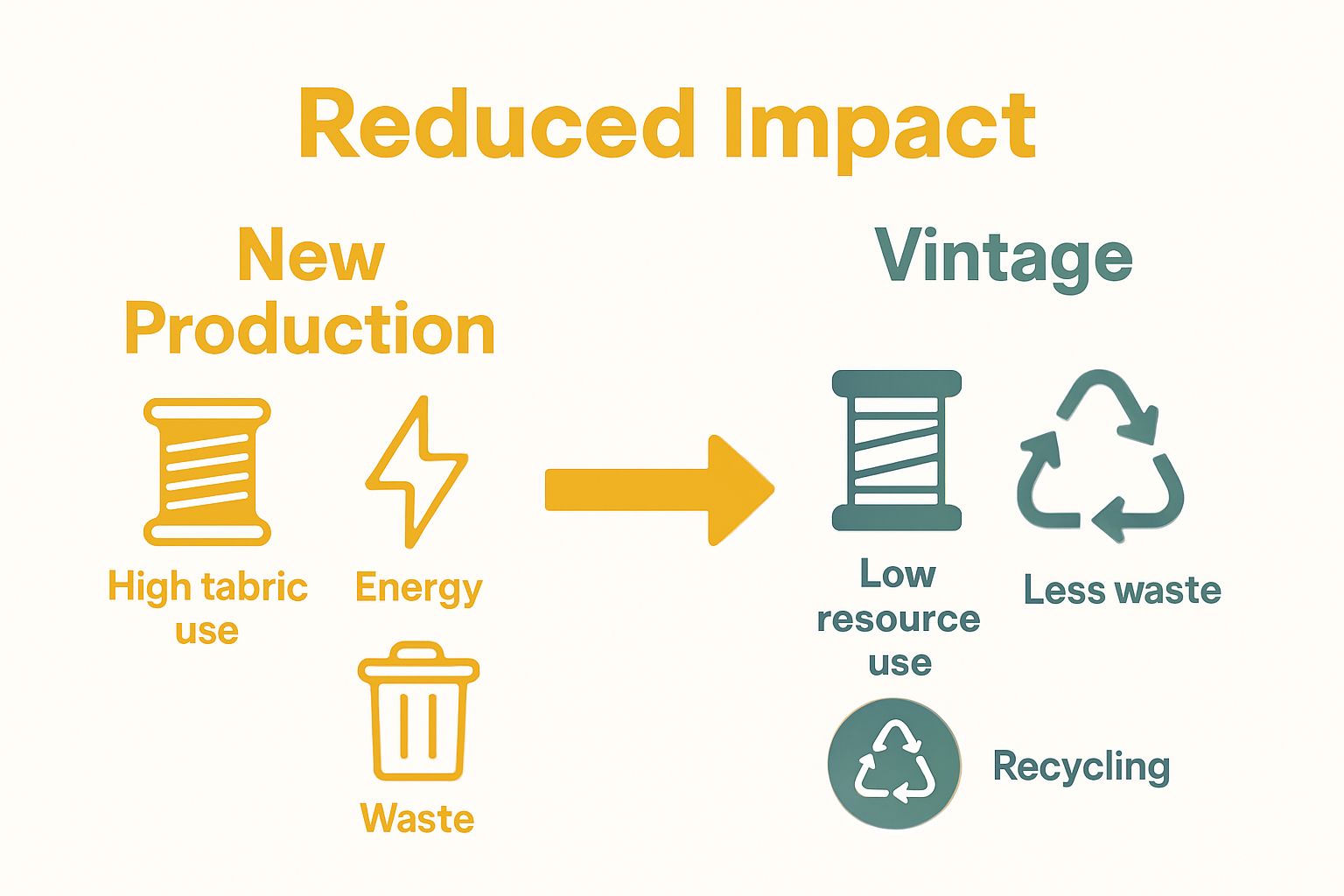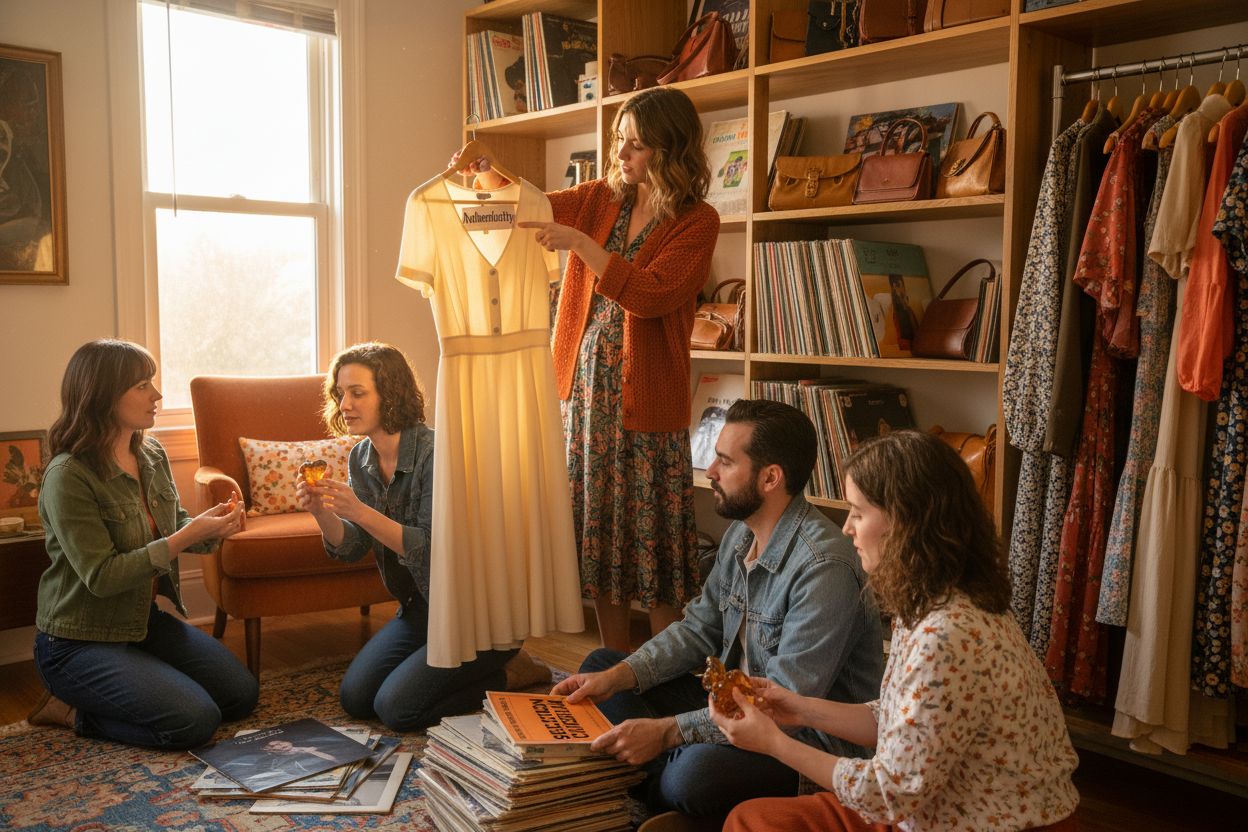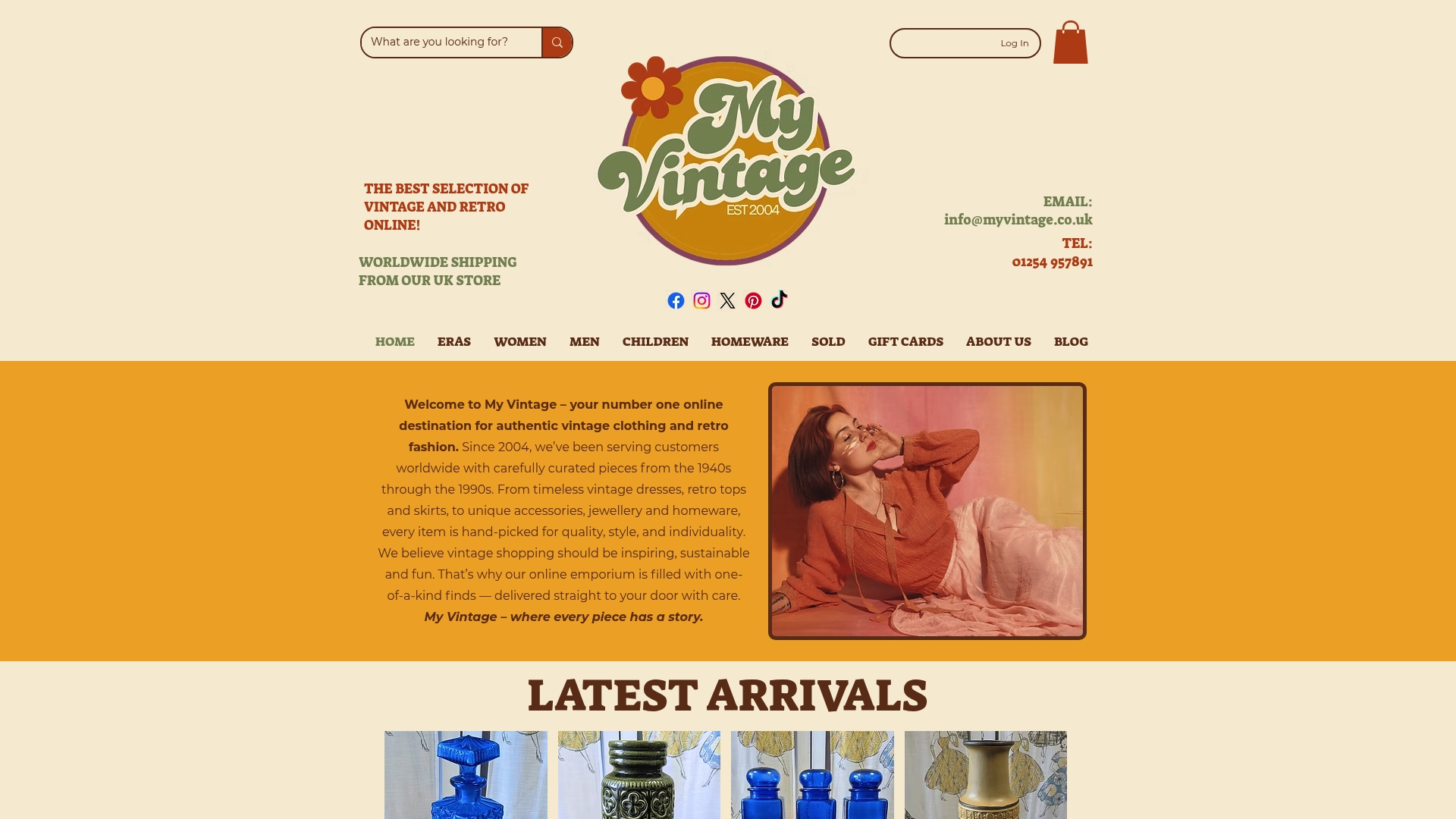Why Curate a Vintage Collection?
- Emma

- Oct 11
- 9 min read

Vintage collections are making waves far beyond the world of nostalgia, quietly shaping fashion and design with their rich stories and rare finds. Yet despite the thrill of discovery, only a tiny fraction of vintage items, sometimes as low as 5 percent, meet the strict standards set by dedicated curators. Most assume collecting is just about amassing old things, but curating vintage is actually about crafting a narrative and preserving cultural heritage in a way that influences trends for decades to come.
Table of Contents
Quick Summary
Takeaway | Explanation |
Curating vintage is intentional selection. | It involves thoughtfully choosing items based on historical significance rather than random accumulation. |
Preserve items to maintain cultural significance. | Proper care and knowledge enrich the historical narratives that each vintage piece represents. |
Vintage choices contribute to sustainable fashion. | Choosing vintage reduces demand for new production, thus minimising environmental impact and promoting circular economies. |
Collecting vintage tells meaningful design stories. | Each selected item reflects a larger narrative about its era, offering insights into historical design and culture. |
Engage with historical context for curation. | Understanding authenticity and provenance enhances the value and meaning of vintage items in a collection. |
What does it mean to curate a vintage collection?
Curating vintage collections represents a nuanced approach to acquiring, preserving, and presenting historically significant or aesthetically compelling items from past eras. It transcends mere collection and transforms into an intentional practice of selecting, organizing, and contextualizing pieces that tell a meaningful narrative about design, culture, and personal style.
The Conceptual Framework of Curation
At its core, curating vintage collections involves thoughtful selection rather than random accumulation. Collectors meticulously evaluate each potential item against specific criteria such as historical authenticity, craftsmanship, condition, and cultural significance. This process requires deep knowledge of historical design periods, understanding material quality, and recognising unique characteristics that distinguish exceptional vintage pieces.
The curation process is not simply about ownership but about creating a cohesive narrative. Each selected item becomes part of a larger story, representing a particular moment in design history or embodying the aesthetic sensibilities of a specific era. Learn more about understanding vintage style to appreciate the intricate details of this practice.
Key Elements of Effective Vintage Curation
Successful vintage collection curation involves several critical components:
Intentional Selection: Choosing items that represent a particular theme, period, designer, or aesthetic
Preservation Knowledge: Understanding proper storage, maintenance, and conservation techniques
Contextual Understanding: Researching the historical and cultural background of collected pieces
Personal Aesthetic Alignment: Ensuring collected items resonate with the curator’s individual style and vision
Curating vintage collections is ultimately an art form that blends historical appreciation, personal creativity, and a deep respect for craftsmanship. It transforms collecting from a passive hobby into an active, intellectual engagement with material culture and design history.
The following table summarises the key elements of effective vintage curation, highlighting their focus and why each is significant to the curatorial process.
Key Element | Focus | Why It Matters |
Intentional Selection | Choosing items fitting a theme or vision | Ensures the collection tells a cohesive story |
Preservation Knowledge | Understanding storage and conservation | Maintains historical and material integrity of pieces |
Contextual Understanding | Researching cultural/historical background | Enriches meaning and enhances connection to the item’s origins |
Personal Aesthetic Alignment | Resonance with curator’s style | Reflects individuality and personal narrative in the collection |
The Importance of Vintage Collections in Fashion and Design
Vintage collections represent far more than nostalgic memorabilia they are pivotal historical archives that document the evolution of aesthetic expression, technological innovation, and cultural transformation through material artefacts. By preserving and studying these collections, we gain profound insights into the social, economic, and creative landscapes of different eras.
Cultural and Historical Documentation
Vintage collections serve as tangible historical records, capturing the zeitgeist of specific periods. Fashion and design pieces are not merely objects but complex narratives that reveal societal values, technological capabilities, and artistic movements of their time. Explore how vintage impacts contemporary style choices to understand the deep interconnectedness of design across generations.
These collections provide unparalleled documentation of craftsmanship, manufacturing techniques, and design philosophies that might otherwise be forgotten. Textile historians, fashion researchers, and cultural anthropologists rely on vintage collections to reconstruct nuanced understandings of past societies.
Sustainable Fashion and Design Preservation
Vintage collections play a critical role in promoting sustainable practices within the fashion and design industries. By valuing and maintaining existing objects, collectors contribute to:
Reducing demand for new manufacturing
Preserving rare and exceptional design examples
Challenging the disposable culture of contemporary consumption
Highlighting the longevity and timeless quality of well-crafted items
Moreover, these collections serve as inspirational resources for contemporary designers, offering rich reference points for innovative reinterpretations and sustainable design strategies. They demonstrate that true style transcends temporal boundaries, encouraging a more thoughtful and environmentally conscious approach to creativity and consumption.
Sustainability: The Role of Vintage in Eco-Conscious Choices
Vintage fashion represents a powerful intersection between style, historical preservation, and environmental responsibility. By embracing vintage clothing and accessories, consumers actively participate in a sustainable fashion ecosystem that challenges traditional linear consumption models and promotes circular economic principles.
Environmental Impact of Fashion Consumption
The contemporary fashion industry generates significant environmental challenges, with mass production contributing substantially to global carbon emissions and textile waste. Vintage collections offer a transformative alternative, reducing demand for new manufacturing and preventing perfectly functional garments from entering landfills. Discover the ultimate sustainable fashion choice to understand the profound ecological benefits of vintage clothing.
By choosing vintage pieces, consumers dramatically reduce their carbon footprint and support a more responsible approach to personal style.

Each vintage item represents a form of textile recycling that preserves resources and minimises environmental degradation associated with contemporary clothing production.
Economic and Ecological Benefits
The sustainability of vintage fashion extends beyond environmental considerations and encompasses broader economic and social implications:
Resource Conservation: Reusing existing garments reduces raw material extraction
Energy Efficiency: Avoiding new manufacturing processes saves significant energy
Waste Reduction: Preventing textile disposal and promoting circular fashion economies
Cultural Preservation: Maintaining historical design narratives and craftsmanship
Ultimately, vintage collections represent more than aesthetic choices they embody a comprehensive commitment to sustainable consumption, demonstrating how individual fashion decisions can contribute to meaningful environmental and social transformations.
Key Concepts Behind Choosing Vintage Items
Selecting vintage items is a sophisticated process that transcends simple aesthetic appreciation, requiring deep understanding of historical context, material quality, and design significance. Collectors and enthusiasts approach vintage curation as an intellectual and creative endeavour that combines historical research, personal taste, and expert evaluation.
Authenticity and Provenance
Authenticity stands as the foundational principle in vintage item selection. Discerning collectors meticulously examine each piece’s historical accuracy, manufacturing techniques, and original context. Explore what defines authentic vintage to understand the nuanced criteria that distinguish genuine historical artefacts from mere replicas.
Provenance becomes crucial in this evaluation process. A well-documented history that traces an item’s origins, previous ownership, and cultural significance dramatically enhances its value and collectibility. Textile markers, manufacturing labels, and period-specific design elements serve as critical indicators of an item’s genuine vintage status.
Evaluation Criteria for Vintage Selection
Successful vintage item curation involves comprehensive assessment across multiple dimensions:
Condition: Examining material integrity, preservation quality, and potential restoration needs
Historical Significance: Understanding the item’s cultural and design context
Rarity: Assessing the uniqueness and scarcity of the piece within its historical period
Craftsmanship: Evaluating the quality of construction, materials, and design techniques
The selection process requires a balanced approach that considers both objective historical metrics and subjective aesthetic appreciation.

Collectors must develop a nuanced understanding that combines scholarly research with personal creative vision, transforming vintage item selection from a simple purchase into an art form of historical interpretation and preservation.
This table outlines the main criteria used to evaluate and select vintage items, helping collectors determine which pieces truly belong in a thoughtfully curated vintage collection.
Evaluation Criterion | Description |
Condition | Material integrity, preservation state, and potential restoration |
Historical Significance | Cultural impact and context within its design era |
Rarity | Uniqueness and scarcity among similar period items |
Craftsmanship | Quality of construction, materials, and design techniques |
Authenticity | Genuine manufacturing period, provenance, and historical accuracy |
How Curating Vintage Collections Influences Trends and Culture
Vintage collections function as dynamic cultural archives, actively shaping contemporary aesthetic sensibilities and challenging mainstream fashion narratives. By preserving and recontextualising historical design elements, collectors serve as critical interpreters who transform historical artefacts into powerful vehicles of cultural expression and creative innovation.
Reimagining Design Narratives
Vintage curation operates as a sophisticated dialogue between past and present, where historical design pieces are not merely preserved but reinterpreted through contemporary perspectives. Discover why vintage fashion continues to return and understand how these cyclical revivals reshape cultural aesthetics.
Designers and creative professionals consistently draw inspiration from vintage collections, using historical references to challenge existing design paradigms.
These collections provide rich visual and conceptual vocabularies that inform contemporary creative practices across fashion, art, and design disciplines.
Cultural Transmission and Aesthetic Evolution
Vintage collections facilitate complex processes of cultural transmission by enabling direct engagement with historical design languages:
Generational Knowledge Transfer: Preserving design techniques and aesthetic philosophies
Challenging Contemporary Standardisation: Introducing diversity and alternative design perspectives
Celebrating Craftsmanship: Highlighting historical manufacturing techniques and material excellence
Promoting Design Diversity: Showcasing design approaches beyond current mainstream trends
Ultimately, curating vintage collections represents an active form of cultural preservation that transcends passive archival practices. By carefully selecting, contextualising, and presenting historical items, collectors contribute to ongoing narratives of aesthetic evolution, challenging linear perceptions of design progress and encouraging more nuanced, interconnected understandings of cultural creativity.
Elevate Your Vintage Curation with My Vintage
Are you passionate about the thoughtful selection and preservation of authentic vintage items, but frustrated by the difficulty of finding pieces that meet your standards for quality, provenance, and true individuality? The challenge of curating a vintage collection is not just about amassing objects—it is about building a meaningful narrative with items that speak to important historical eras and represent your own unique style. Many collectors struggle to source clothing and homeware that truly align with their values for sustainability and cultural significance.

Let My Vintage help you bridge the gap between education and action. Our platform is devoted to supplying genuine vintage fashion and retro homeware from trusted sources, carefully sorted by era and style. Whether you seek rarities for your personal archive or a standout piece for your next project, start exploring our curated selection today. Do not miss the chance to create a collection with both style and substance—visit My Vintage now and discover why true curators trust our expertise. Your next piece of history is waiting.
Frequently Asked Questions
Why should I curate vintage collections instead of simply collecting items?
Curating vintage collections allows you to create a meaningful narrative and context around each item, enhancing the overall experience of ownership. Start by selecting pieces that represent specific themes or eras, helping you build a cohesive story that reflects your interests.
What are the key criteria for selecting items in a vintage collection?
When curating vintage collections, focus on historical authenticity, craftsmanship, condition, and cultural significance. Evaluate each potential addition to your collection by considering these factors, which can help you make informed decisions on what to include.
How can I ensure the preservation of my vintage items?
Proper preservation techniques include careful storage, regular maintenance, and understanding the specific needs of different materials. Implement a preservation plan that involves assessing storage conditions every few months to ensure optimal care of your collection.
What role does authenticity play in vintage curation?
Authenticity is crucial in vintage curation as it helps establish the historical value and provenance of each piece. Begin by researching the origins and manufacturing techniques of items to ensure they meet genuine vintage criteria and enhance your collection’s value.
How does curating vintage collections promote sustainable practices?
Curating vintage collections promotes sustainability by reducing demand for new manufacturing and encouraging the reuse of existing items. Focus on building your collection with items that highlight quality and longevity, which can contribute to a more eco-conscious approach to fashion and design.
What are the benefits of understanding the historical context of my vintage items?
Understanding the historical context allows you to appreciate the design and cultural significance of each piece, enriching your collecting experience. Dive into research about the time periods represented in your collection to create more informed narratives around your items.
Recommended







